ST Engineering iDirect + Hellas Sat Have Validated Hybrid 5G Satellite Backhaul Use Cases
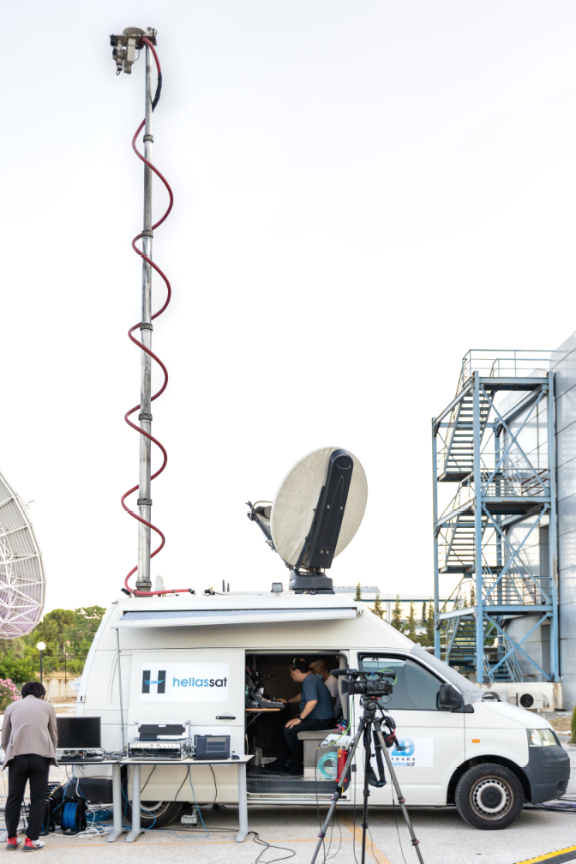
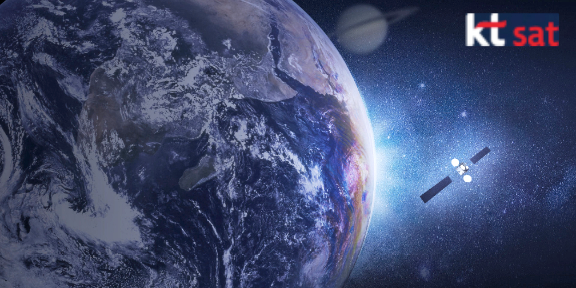
ST Engineering iDirect and satellite operator Hellas Sat have successfully validated hybrid, 5G backhauling use cases over satellite. Showcasing a completely seamless transition between terrestrial and satellite-based networks, the demonstration confirms the critical role that satellite will play in the 5G ecosystem through its capability to broaden coverage to hard-to-reach areas as well as further reinforces its cellular backhaul capabilities across Hellas Sat’s satellite coverage.
The demonstration was organized in partnership with Korean satellite operator KT-SAT, with Thales Alenia Space and Vodafone Greece which held the first 5G satellite backhauling demonstration in February 2021. It showcased how satellite can enable increased coverage in areas where traditional backhauling technologies are either unsuitable or not cost-effective.
ST Engineering iDirect’s Evolution® hub and modem equipment supported the transmission on the Hellas Sat 3 satellite and Vodafone Greece’s 5G spectrum in the 2100 MHz and 3600 MHz frequency zones.
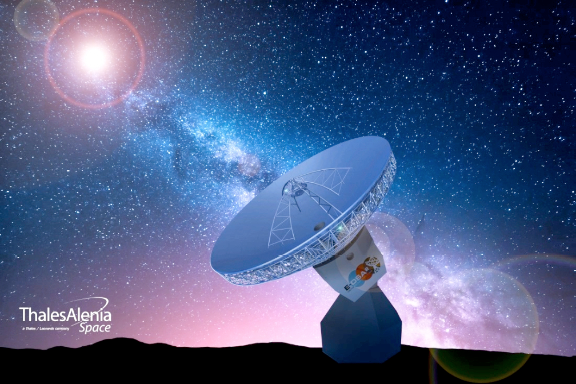
KT-SAT also provided its world’s-first hybrid router for satellite-terrestrial 5G transmission. 5G terminals were connected to the router to simultaneously transmit and receive various types of data, or use separate routes to and from a 5G network and a satellite. The terminals successfully maintained normal service operations with the Hellas Sat 3 satellite connectivity, even after the 5G network was intentionally disconnected.
Executive Comment
“This demonstration is another step toward the commercialization of 5G backhaul over satellite services,” said Semir Hassanaly, Head of Cellular Backhaul and Trunking at ST Engineering iDirect. “It shines a light on the critical role that satellite is going to play in the future of connectivity. As 5G becomes more prevalent, it’s essential that remote communities, moving vehicles and other users of 5G connectivity, are connected ubiquitously and continuously. We are immensely proud to be involved in this demonstration and thank Hellas Sat for this opportunity to showcase the capabilities of hybrid satellite and terrestrial connectivity with these other pioneering companies.”
NASA’s Double Asteroid DART Mission Launched By SpaceX
NASA’s Double Asteroid Redirection Test (DART), t he world’s first full-scale mission to test technology for defending Earth against potential asteroid or comet hazards, launched on Wednesday, November 24, at 1:21 a.m., EST, on a SpaceX Falcon 9 rocket from Space Launch Complex 4 East at Vandenberg Space Force Base in California. This was the third flight for this Falcon 9’s first stage booster, which previously supported launch of Sentinel-6 Michael Freilich and a Starlink mission.
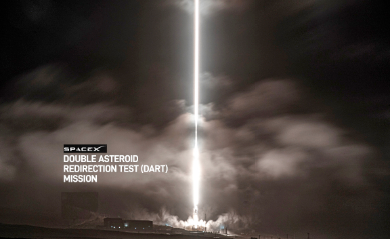
Photo of the SpaceX Falcon 9 launch of NASA’s
DART mission from Vandenberg Space Force Base.
Image is courtesy of the company.
Just one part of NASA’s larger planetary defense strategy, DART – built and managed by the Johns Hopkins Applied Physics Laboratory (APL) in Laurel, Maryland – will impact a known asteroid that is not a threat to Earth. Its goal is to slightly change the asteroid’s motion in a way that can be accurately measured using ground-based telescopes.
DART will show that a spacecraft can autonomously navigate to a target asteroid and intentionally collide with it – a method of deflection called kinetic impact. The test will provide important data to help better prepare for an asteroid that might pose an impact hazard to Earth, should one ever be discovered.
DART’s one-way trip is to the Didymos asteroid system, which comprises a pair of asteroids. DART’s target is the moonlet, Dimorphos, which is approximately 530 feet (160 meters) in diameter. The moonlet orbits Didymos, which is approximately 2,560 feet (780 meters) in diameter. As Dimorphos orbits Didymos at much a slower relative speed than the pair orbits the Sun, the result of DART’s kinetic impact within the binary system can be measured much more easily than a change in the orbit of a single asteroid around the Sun.
LICIACube, a cubesat riding with DART and provided by the Italian Space Agency (ASI), will be released prior to DART’s impact to capture images of the impact and the resulting cloud of ejected matter. Roughly four years after DART’s impact, the European Space Agency’s Hera project will conduct detailed surveys of both asteroids, with particular focus on the crater left by DART’s collision and a precise determination of Dimorphos’ mass.
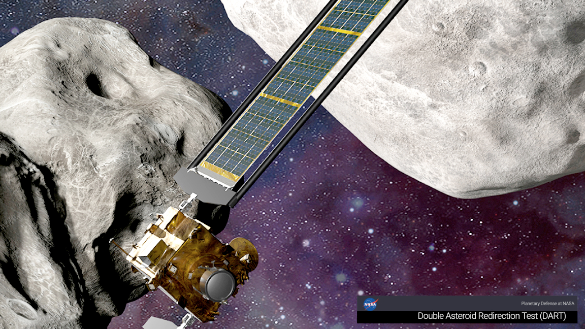
At 2:17 a.m., DART separated from the second stage of the rocket. Minutes later, mission operators received the first spacecraft telemetry data and started the process of orienting the spacecraft to a safe position for deploying its solar arrays. About two hours later, the spacecraft completed the successful unfurling of its two, 28-foot-long, roll-out solar arrays. They will power both the spacecraft and NASA’s Evolutionary Xenon Thruster – Commercial ion engine, one of several technologies being tested on DART for future application on space missions.
Glenn engineers assemble a NASA Evolutionary Xenon Thruster (NEXT) for testing. NEXT is a next generation propulsion system that could revolutionize science missions are sent deeper into the solar system. The thruster will use xenon gas and electrical power to drive future spacecraft.
The spacecraft will intercept the Didymos system between Sept. 26 and Oct. 1, 2022, intentionally slamming into Dimorphos at roughly 4 miles per second (6 kilometers per second). Scientists estimate the kinetic impact will shorten Dimorphos’ orbit around Didymos by several minutes. Researchers will precisely measure that change using telescopes on Earth. Their results will validate and improve scientific computer models critical to predicting the effectiveness of the kinetic impact as a reliable method for asteroid deflection.
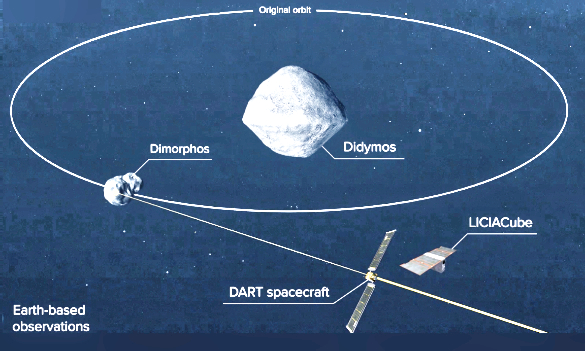
DART’s single instrument, the Didymos Reconnaissance and Asteroid Camera for Optical navigation (DRACO), will turn on a week from now and provide first images from the spacecraft. DART will continue to travel just outside of Earth’s orbit around the Sun for the next 10 months until Didymos and Dimorphos will be a relatively close 6.8 million miles (11 million kilometers) from Earth.
A sophisticated guidance, navigation, and control system, working together with algorithms called Small-body Maneuvering Autonomous Real Time Navigation (SMART Nav), will enable the DART spacecraft to identify and distinguish between the two asteroids. The system will then direct the spacecraft toward Dimorphos. This process will all occur within roughly an hour of impact.
“DART is turning science fiction into science fact and is a testament to NASA’s proactivity and innovation for the benefit of all,” said NASA Administrator Bill Nelson. “In addition to all the ways NASA studies our universe and our home planet, we’re also working to protect that home, and this test will help prove out one viable way to protect our planet from a hazardous asteroid should one ever be discovered that is headed toward Earth.”
Gilat Satellite Networks Extends Africa Mobile Networks Coverage

Gilat Satellite Networks Ltd. (Nasdaq: GILT, TASE: GILT) has announced that Africa’s largest satellite cellular backhaul network is extending its coverage to a dozen countries in Africa — Africa Mobile Networks (AMN) has deployed Gilat hubs and placed additional orders of Gilat cellular backhaul terminals to serve multiple Tier-1 Telcos in Africa.

Executive Comments
“AMN has selected Gilat, due to its superior cellular backhaul over satellite technology, to support the extension of Africa’s largest satellite-based network,” said Michael Darcy, CEO AMN.

“We are pleased to contribute to closing the digital divide by furthering the reach of our network with Gilat’s SkyEdge II-c Capricorn VSATs, reaching more of the population in Africa.”
“Gilat highly values its long-lasting partnership with AMN and shares a common goal of enhancing the lives of people in Africa with high quality connectivity,” said Michal Aharonov, Chief Commercial Officer at Gilat. “Gilat is working closely with AMN to further expand cellular backhaul reach in additional sites and regions throughout the coming years, including migration to 4G as the requirement for data communication rises.”
NASA’s Space Station Replacement Development Design Awards Nanoracks, Voyager Space + Lockheed Martin
Nanoracks, in collaboration with Voyager Space and Lockheed Martin [NYSE: LMT], has been awarded a $160 million contract by NASA to design its Starlab commercial space station as part of the agency’s Commercial Low-Earth Orbit (LEO) Development program.
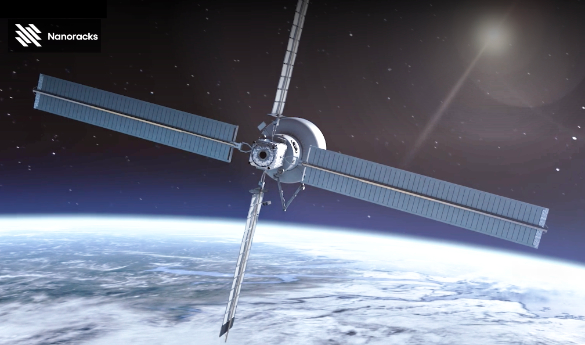
Starlab will enable NASA’s initiative to stimulate the commercial space economy and provide science and crew capabilities prior to the retirement of the International Space Station (ISS).
The initial $160 million award to Nanoracks is made via a funded Space Act Agreement through 2025. This initial NASA-provided funding will be supplemented with customer pre-buy opportunities and public-private partnerships. Fully owned by Nanoracks, Starlab is planned to reach initial operating capability in 2027, which ensures continuous human presence in LEO by U.S. entities. NASA will have the opportunity to purchase crew and payload services on Starlab through separate services contracts with Nanoracks.
Nanoracks has unparalleled commercial experience on the ISS. Joined by Voyager Space’s sophisticated investment strategy and expertise in operational integration and Lockheed Martin’s engineering knowledge and strategic vision, the Starlab team presented a formidable program for the future of LEO commercialization.
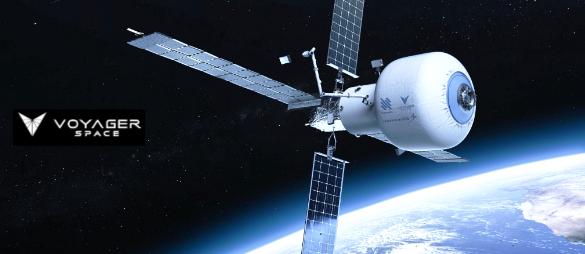
The basic elements of the Starlab space station include a large inflatable habitat, designed and built by Lockheed Martin, a metallic docking node, a power and propulsion element, a large robotic arm for servicing cargo and payloads, and the George Washington Carver (GWC) Science Park. The GWC Science Park is a state-of-the-art laboratory system which will host a comprehensive research, science, and manufacturing capability. Starlab will have the capacity to continuously host up to four astronauts to conduct critical science and research.
Nanoracks will prime Starlab’s development leveraging more than a decade of experience as the pathfinder and global leader in commercial ISS utilization. Voyager Space, the majority shareholder in Nanoracks, will lead strategy and capital investment, and Lockheed Martin, a leader in developing and operating complex space technology, will serve as the technical integrator of the new advanced space station.
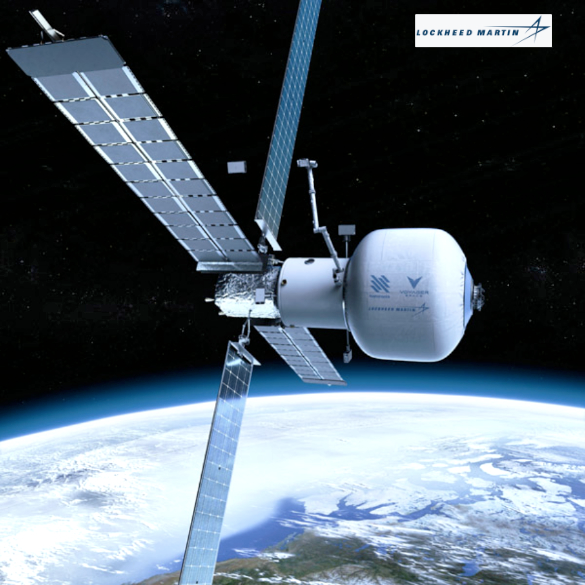
A Voyager Space created StarLab video is available at this direct link… “While today marks a major milestone for Nanoracks and our Starlab team, the impact goes far beyond this award,” said Dr. Amela Wilson, CEO at Nanoracks. “To receive this support from NASA validates over a decade of Nanoracks’ hard work forging commercial access to space, bringing over 1300 commercial payloads from 30 nations to the ISS. This opportunity opens far-reaching possibilities for critical research and commercial industrial activity in LEO. We are honored to be selected as one of three awardees to work with NASA, and we cannot wait to bring our existing global commercial customer base to Starlab.”
“Starlab is the confluence of Lockheed Martin’s rich space expertise and history, Nanoracks’ innovation, and Voyager’s financial savvy. This team is equipped to aid NASA on its mission to expand access to LEO and to enable a transformative commercial space economy,” said Lisa Callahan, Vice President and General Manager, Commercial Civil Space at Lockheed Martin.
“Starlab’s impact on space commercialization cannot be understated,” said Dylan Taylor, Chairman and CEO at Voyager Space. “Today we are witnessing a major economic shift, where space businesses are tangible, well capitalized, and commercially sustainable. It takes a planet to explore the universe, and we invite the global community to be part of Starlab’s success.”
CGI Set To Develop Hybrid SATCOM + Network For Implementation On Trains
CGI (NYSE: GIB) (TSX: GIB.A) has been selected by the UK Department for Digital, Culture, Media and Sport, the UK Space Agency and the European Space Agency (ESA) to develop a demonstration of a hybrid satellite communications and terrestrial network for use on trains.
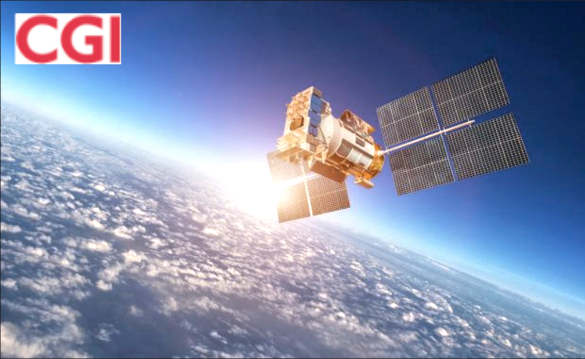
The project is part of a joint initiative in the UK to demonstrate the integrated use of 5G in the area of transport and logistics. This Satellites for Digitalization of Railways (SODOR) project will deliver pilot demonstrations of improved network connectivity for train monitoring and passenger broadband in 2022. The project aims to demonstrate how new constellations of communication satellites can seamlessly fill gaps in terrestrial coverage and provide additional capacity to improve safety and provide travelers with better connectivity.
CGI will work with IT partners Icomera, Isotropic and 5G3i, alongside Network Rail, and rail operators ScotRail, Northern and LNER, to explore how hybrid networks, based on multi-bearer 5G technology, can improve network availability while offering better value for money than existing solutions.
Mike Rudd, Head of Telecommunications, UK Space Agency, said, “Satellites play a vital role in keeping people connected, but they can also help keep us safe by providing reliable communications links between trains, drivers and operators. This new project is a great example of the National Space Strategy in action, drawing on CGI’s expertise in satellite communications and working closely with our partners in the ESA to demonstrate how this technology could help supercharge mobile connectivity across the national rail network.”

UK Minister for Media, Data and Digital Infrastructure, Julia Lopez, said, “We want to end the frustration of cut-short calls and internet black-outs on trains and bring our network into the fast lane. We’re delighted to select CGI to test how satellites and 5G can put an end to patchy mobile coverage while helping train operators monitor the safety and performance of their services with greater precision. This is just one of a long list of projects we are backing to boost our economy and improve people’s lives with modern technology.”
Rita Rinaldo at ESA said, “We trust that the SODOR project will demonstrate the unique contribution of 5G integrated satellite- terrestrial connectivity in providing good quality passenger communications for remote regions, solving the problems experienced today by main train users. Thanks to the support of Network Rail and other train operators, this will pave the way for a wider adoption of satellite communications for rail applications, including in the context of the Future Railway Mobile Communication System.”
Shaun Stretton, Senior Vice President, UK & Australia Space Control and Information Solutions at CGI, said, “In today’s world, consumers have come to rely on ubiquitous access to the internet and losing a mobile signal on a train journey is no longer an acceptable inconvenience. It also has commercial implications for the operator and, under some circumstances, could even present a safety issue for drivers. We are pleased to be working with ESA and the UK Government, along with a wide range of partners, to demonstrate how bringing together satellite communications and terrestrial networks will solve this. CGI is uniquely positioned to unlock these benefits through our experience and IT capabilities across the space, telecoms and rail domains.”

SODOR will deliver the following:
• Improved on-train communications for employees and passengers, with network aggregation for 3G and 4G and a roadmap for 5G a choice of satellite constellations dependent on bandwidth and location to ensure a reliable signal
• Cost-effective communications, including tools to optimize network selection based on cost and performance • Operations and management portal
• Internet of Things (IoT) sensor solutions to support connected train monitoring
Founded in 1976, CGI is among the largest independent IT and business consulting services firms in the world. With 80,000 consultants and other professionals across the globe, CGI delivers an end-to-end portfolio of capabilities, from strategic IT and business consulting to systems integration, managed IT and business process services and intellectual property solutions. CGI works with clients through a local relationship model complemented by a global delivery network that helps clients digitally transform their organizations and accelerate results. CGI Fiscal 2021 reported revenue is $12.13 billion and CGI shares are listed on the TSX (GIB.A) and the NYSE (GIB).


